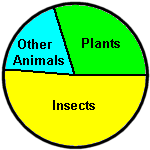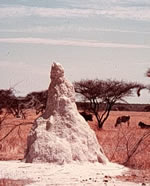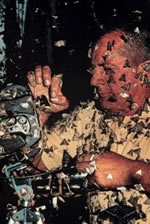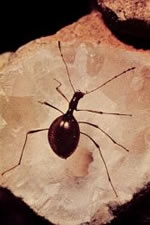A Class of Distinction
 We humans are such a self-centered species that we seldom stop to acknowledge or appreciate the importance of other living organisms in our environment. Our prowess in science and technology has given us unparalleled control over our physical environment, and as a result, we have developed an inflated view of our own importance in the web of life. Although we have learned to use tools, dam rivers, level mountains, and harness atomic power, we are still dependent on Mother Nature for the countless housekeeping chores that keep our environment stable and healthy. Indeed, we are relatively minor players in the ecological drama that continually unfolds all around us. If humans were to suddenly vanish from the planet, there would be no ecological calamity, no massive extinctions, and no tears shed for our demise. Remnants of human civilization would soon be smothered in vegetation, the forests would reclaim our cities, and life would go on without us just as it did for millions of years before our ancestors first reckoned the passage of time. Sadly, the earth would probably be better off without us.
We humans are such a self-centered species that we seldom stop to acknowledge or appreciate the importance of other living organisms in our environment. Our prowess in science and technology has given us unparalleled control over our physical environment, and as a result, we have developed an inflated view of our own importance in the web of life. Although we have learned to use tools, dam rivers, level mountains, and harness atomic power, we are still dependent on Mother Nature for the countless housekeeping chores that keep our environment stable and healthy. Indeed, we are relatively minor players in the ecological drama that continually unfolds all around us. If humans were to suddenly vanish from the planet, there would be no ecological calamity, no massive extinctions, and no tears shed for our demise. Remnants of human civilization would soon be smothered in vegetation, the forests would reclaim our cities, and life would go on without us just as it did for millions of years before our ancestors first reckoned the passage of time. Sadly, the earth would probably be better off without us.
In simplest terms, life (as we know it) exists on planet earth because of a global cycle of production and consumption that hinges almost exclusively on green plants as primary producers and insects as primary consumers. These two life-forms overshadow all other multi-cellular organisms in terms of abundance and diversity. They are mutually dependent on one another for survival, and form a nucleus around which all terrestrial and fresh-water ecosystems are built. Without green plants and the organic molecules they produce through photosynthesis, all animal life would collapse from starvation. Without insects and other decomposers, green plants would quickly exhaust their nutrient supplies, dead organic matter would accumulate in putrid, rotting heaps, and many species of flowering plants would become extinct for lack of insect pollinators.

In a sense, we owe our very existence to members of the insect world — creatures we often fear or despise. We expend considerable resources trying to eliminate these animals from every facet of our daily lives, but in fact, we could never hope to survive without them — they make the earth habitable for us. Like tiny maids and butlers, they perform Nature’s housekeeping tasks with competence and efficiency. Nothing else — animal, vegetable, or mineral — could ever take their place. By virtue of their diversity, their world-wide distribution, their ecological importance, and their impact on other life-forms, the insects are indeed a class of distinction.
The Dominance of Insects

Figure 1
Number of Species
There are several ways to measure or assess the dominance of insects. Perhaps the simplest approach is to compare the total number of insect species with similar totals for other taxonomic groups. By such an accounting, entomologists estimate that roughly 1.12 million insect species have been named and described since Carolus Linnaeus (1707-1778) founded the modern system of nomenclature (genus and species) for all plants and animals. The entire plant kingdom, by comparison, contains between 400,000 and 500,000 species. In the animal kingdom, the “lower” invertebrates account for around 320,000 species, while vertebrates total only about 65,000 species. Thus, insects represent more than half (about 53%) of the 2.13 million species of living organisms known to science (Figure 1). But the catalogue of life is not yet complete! Discovery of a new species of vertebrate is a rare event — only a handful have been found in the past 20 years. But millions of undiscovered insect species are still hiding in the soil, in the canopies of tropical rain forests, and even right in our own backyards. Entomologists describe hundreds of these new species each year, and still estimate that only one-half to one-third of the earth’s total insect fauna has even yet been discovered. In the final analysis, two of every three living species may be insects.

Australian Termite Mound
Number of individuals
Another way to look at the dominance of insects is to consider the distribution and density of individual species or populations. Because of their small size and high reproductive potential, insect populations often grow to epic proportions. A single colony of Australian termites can swell to several million individuals within an earthen mound 20-25 feet tall. A swarm of migratory locusts may contain up to 10 billion individuals, cover an area of several thousand hectares, and have a total biomass of over 30,000 metric tons. Above the arctic circle, hordes of mosquitoes and black flies can make life miserable for any warm-blooded animal. In some cases, these biting flies are so abundant and persistent that large animals, such as reindeer, have been known to die from the massive loss of blood (desanguination). In the tropics, ants are the most pervasive and diverse of all animal species. Colonies of driver ants (Dorylus sp.) on the African savannah may contain 20 million individuals.

Even temperate forests and grasslands support unbelievably large populations of insects. As many as 40,000 cicadas (Magicicada septendecim) may feed on the roots of a large fruit tree. Grape leafhoppers (Erythroneura spp.) reach populations as dense as 30 million per hectare in some vineyards. A “supercolony” of ants (Formica yessensis) that covered 250 hectares (nearly a square mile) of coastal real estate near Sapporo, Japan reportedly contained over a million queens and 300 million workers living in a network of 45,000 interconnected nests. Admittedly, these are extreme examples, but even one stink bug per meter of row in a soybean field equals a population of more than 125,000 per hectare. In fact, the insects are so numerous that if they were divided equally among each one of the earth’s 6 billion human inhabitants, each of us would be allotted 1 x 1018 insects — that’s a billion billion — 1,000,000,000,000,000,000.

Ice Beetle
Distribution
A third way to assess the dominance of insects is to examine their abundance and diversity in a wide range of ecological habitats. Indeed, insects are found in virtually every terrestrial and fresh-water environment on the face of the earth. They live everywhere from mountain tops in the Himalayas to tide pools at the seashore. Dozens of eyeless species spend their entire lives in the total darkness of underground caverns. At least 40 species live on the polar ice caps of Antarctica, others exist on the surface of glaciers, or near the edge of melting snow fields. A few species can survive in hot springs where the water temperature is 50oC; others inhabit deserts where water is scarce and daytime temperatures exceed 60oC. Insects live both above and below the surface of rivers, streams, lakes, and ponds. One species of water strider makes its home among floating seaweed in the Sargasso Sea, nearly 2400 kilometers (1500 miles) from the nearest land mass. The petroleum fly (Helaeomyia petrolei), develops in pools of crude oil in the California oil fields. A related species, the brine fly (Ephydra cinera), thrives in the high salinity of Utah’s Great Salt Lake. In fact, the only place on earth where insects are not plentiful is in the ocean depths. Most marine environments are filled by another successful group of arthropods, the Crustacea.

